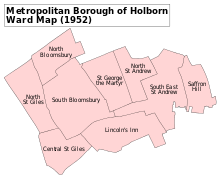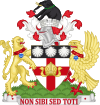Saffron Hill


Saffron Hill is a street and former ward in Holborn, in the south eastern corner of the London Borough of Camden, between Farringdon Road and Hatton Garden. The name of the street derives from the fact that it was at one time part of an estate on which saffron grew. The ecclesiastical parish was St Peter, Saffron Hill, a daughter parish of Holborn, which is now combined with St Alban (the Martyr), Holborn.[1]
In 1850, it was described as a squalid neighbourhood, the home of paupers and thieves. In Charles Dickens's novel Oliver Twist (1837), the Artful Dodger leads Oliver to Fagin's den in Field Lane, the southern extension of Saffron Hill: "a dirty and more wretched place he [Oliver] had never seen. The street was very narrow and muddy, and the air was impregnated with filthy odours".[2]
Little Italy
Saffron Hill is mentioned in the Arthur Conan Doyle Sherlock Holmes story The Adventure of the Six Napoleons, as the Italian Quarter where the Venucci family can be found. The area still retains a local nomenclature of Little Italy. Annually On the nearest Sunday to July 16 the procession of Our Lady of Mount Carmel takes place, a Roman Catholic manifestation of faith starting from St Peter's RC Church on Clerkenwell Road.[3] It was from Saffron Hill that Darby Sabini operated his criminal gangs in the 1920s and 30s[4]
Saffron Hill formed part of the liberty of Saffron Hill, Hatton Garden, Ely Rents and Ely Place which became part of the County of London in 1889. It was abolished in 1900 and formed part of the Metropolitan Borough of Holborn until 1965.
Saffron Hill has become more residential in recent years with the building of several blocks of 'luxury' apartments, including Da Vinci House situated in the former "Punch magazine" printworks and the architecturally distinctive Ziggurat Building.
References
- ^ https://www.achurchnearyou.com/search/?lat=51.52&lon=-0.1075 Church of England - ecclesiastical parish finder
- ^ Dickens, Charles (1838). Oliver Twist: or, The Parish Boy's Progress. New York: Carey, Lea & Blanchard. p. 43. ISBN 91-1-937201-9. Retrieved 28 December 2009 – via Internet Archive website.
Saffron Hill.
- ^ https://hidden-london.com/gazetteer/little-italy/ Hidden London, Little Italy, Camden/Islington
- ^ McDonald Brian, Gangs of London, Milo Books (2010) ISBN 1-903854911
External links
 Media related to Saffron Hill, London at Wikimedia Commons
Media related to Saffron Hill, London at Wikimedia Commons- Photographs of Saffron Hill
- v
- t
- e
- Bloomsbury
- Camden Town
- Chalk Farm and Haverstock ward
- Fortune Green
- Gospel Oak
- Hampstead (inc. Belsize Park, Frognal, Finchley Road, South Hampstead and Swiss Cottage)
- Hatton Garden (inc. Saffron Hill)
- Kentish Town
- Primrose Hill
- Regent's Park Estate
- St Giles
- St Pancras
- Somers Town
- West Hampstead
| Partly in Camden |
|
|---|


- Ben Uri Gallery & Museum
- Bloomsbury Theatre
- British Library
- British Museum
- Brunswick Centre
- BT Tower
- Camden Arts Centre
- Charles Dickens Museum
- Dominion Theatre
- Donmar Warehouse
- Fenton House
- Foundling Museum
- Freud Museum
- Highgate Cemetery
- Keats House
- Kenwood House
- The Jewish Museum
- O2 Forum Kentish Town
- Petrie Museum of Egyptian Archaeology
- Roundhouse
- Shaftesbury Theatre
- Sir John Soane's Museum
- Wellcome Collection
- West End theatre
open spaces
- Hampstead and Kilburn
- Holborn and St Pancras
rail stations
 Belsize Park
Belsize Park Camden Road
Camden Road Camden Town
Camden Town Chalk Farm
Chalk Farm Chancery Lane
Chancery Lane Euston
Euston Euston tube
Euston tube Euston Square
Euston Square Finchley Road
Finchley Road Finchley Road & Frognal
Finchley Road & Frognal Goodge Street
Goodge Street
 Gospel Oak
Gospel Oak Hampstead
Hampstead Hampstead Heath
Hampstead Heath Holborn
Holborn Kentish Town
Kentish Town Kentish Town West
Kentish Town West Kilburn High Road
Kilburn High Road King's Cross
King's Cross King's Cross St Pancras
King's Cross St Pancras Mornington Crescent
Mornington Crescent Russell Square
Russell Square St Pancras
St Pancras South Hampstead
South Hampstead Swiss Cottage
Swiss Cottage Tottenham Court Road
Tottenham Court Road Warren Street
Warren Street West Hampstead
West Hampstead West Hampstead (Overground)
West Hampstead (Overground) West Hampstead Thameslink
West Hampstead Thameslink
- Blue plaques
- Coat of arms
- Council
- Listed buildings
- People
- Public art
- Schools
 Category
Category Commons
Commons
51°31′12.60″N 0°06′23.91″W / 51.5201667°N 0.1066417°W / 51.5201667; -0.1066417
 | This London road or road transport-related article is a stub. You can help Wikipedia by expanding it. |
- v
- t
- e













